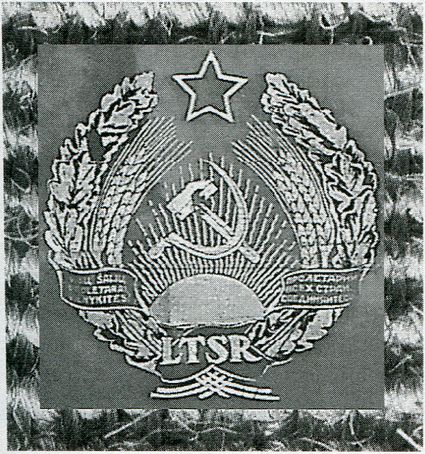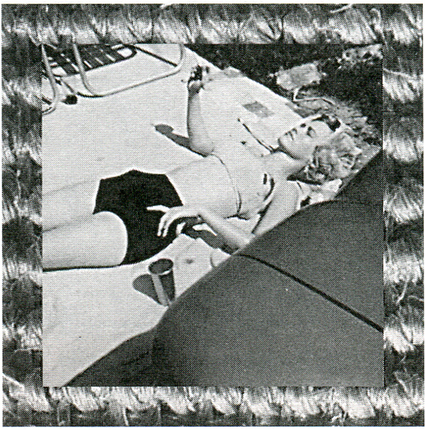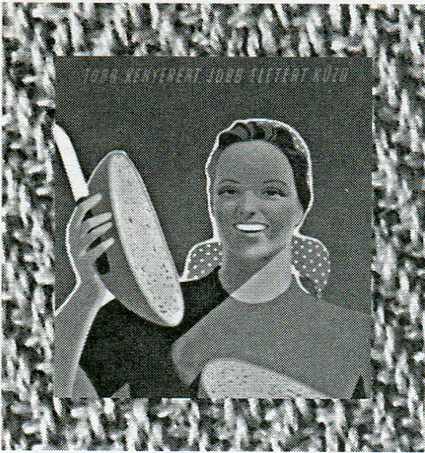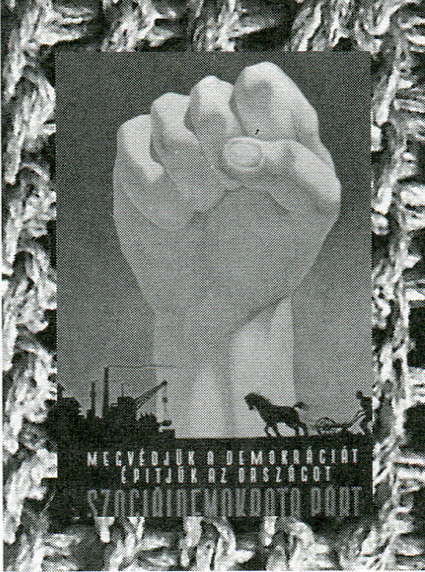In this interview, the San Francisco based artist discusses the designing and programming of interactive art. As a follow-up to the cd-rom, whose subject is Hungary, Legrady recently released on two floppies his new project about the war in Bosnia entitled *, which you can find on the V.O.L.V.O. cd-rom. Alongside such socially oriented works, he also produces conceptually based computer installations which take us along on a voyage to the 'heart of the machine'. Legrady's work could recently be seen at ISEA '94 (Helsinki), Artifices III (Paris) and Ars Electronica '94 (Linz).
This interview was conducted in Budapest, where Legrady taught for several months at the Hungarian Art Academy's new Intermedia department.
An Anecdoted Archive from the Cold War(1993) is an interactive cd-rom installation project which features Central European personal and official Communist material from the 1950's, in the form of home movies, video footage, family documents, money, news reports, identity cards, and other items from a collection Legrady gathered during the past twenty years. The Anecdoted Archive reflects his own particular history in relation to the Cold War. Born in Budapest in 1950 near the end of the Stalin era, George Legrady left with his family for the West during the 1956 Hungarian Revolution.
GLO How did you come up with the idea of putting your collection of Cold War items on a CD-rom?
GLE I didn't want to carry all the material in my head anymore. All these objects, film footage, images, stories needed to be contextualized and brought together into a concrete form so that they could exist on their own and be made accessible to a viewing audience.
GLO Did you have examples before you started?
GLE I had three references when I began the CD-rom. The first was the Worker's Movement Museum up in the castle in Budapest, which of course has now been packed away. I was interested in going there in the early eighties because to me it was extremely visible in terms of its fictional narratives. You saw representations of a worker's living room before and after communism; I enjoyed these comparative narratives. I used the museum's floor plan in my archive to situate all of my stories, both personal and official as a way of interacting with that history. I have also included original material from that museum which I documented in 1983.
The next reference is a Fluxus artist named Daniel Spoerri, who did a work titled An Anecdoted Topography of Chance. This work was created out of the chaotic leftovers he saw on his kitchen table one morning after a party. He produced an archive of the things he found by tracing each objects' history, and adding cross-references. The editor of the book and the translator who were also at the party, added their comments as well. The work has the scientific look and feel of an archive with highly entertaining references. The third reference consists of two books by Michel Foucault, The Order of Things and The Archeology of Knowledge. In these books, Foucault discusses the historical conditions that result through the classification of information. Foucault argues that when archives are created, they become authoritative institutions. They define what is possible and what is not in terms of what can be spoken. What I wanted to do with this archive of mine was to contrast my personal narrative and family's memories about leaving Hungary with material of communist Hungary from the same historical period. You can navigate back-and-forth between personal and official stories. I was interested in creating a hybrid synthesis between these two points of origins in terms of storytelling and as a way to understand that moment of crisis.
An Anecdoted Archive from the Cold War - published in Mediamatic Magazine Vol. 8#2/3 (1995)
GLO In 1983, communism in Hungary was more or less dead, and you had a chance to look at the propaganda in a historical way.
GLE State control rituals were still very much present. At that time I remember seeing groups of peasants being taken officially through the Workers' Movement Museum. At the same time, you could buy books at the front desk with reproductions of early political posters. it was apparent that the real audience for these were not those peasants but the Western tourists who came to see communism. The state at that time recognized the new market potential of the old propaganda.
The work I was doing then was conceptually-based, staged photography, influenced by deconstructing advertising in California. When I came to Budapest in 1983 to do research in the Propaganda Museum I was interested in the construction of ideological narratives during the transitional period to Communism in 1945-'52. My desire was to con
trast them to the advertising narrative strategies that I was coming across in everyday life in California. I am looking forward to presenting my archive in Hungary. I'm pretty sure that it will have different meaning here, to a population that has lived through this material as opposed to a Western audience for whom it might be fundamentally exotic.
Although through time and repetition in the media, these images have been reduced to caricatures. Especially in the art world, it's impossible to look at Socialist Realism today without the additional ironic subtext that re-representation has imposed on it.
GLO What stories of your family can we find on the CD-rom?
GLE There are stories about the house my grandfather purchased in the twenties which was eventually nationalized in the fifties. I'm tracing its story through old home movies and new videos: how he managed to acquire it, how it got nationalized and eventually was turned into a vacation place for factory workers. And then in the seventies it was torched and a hotel was built on its site for workers. But when communism ended the state sold it to a private individual. I like to use comparative scenarios. There's one section with early 1950's old black and white footage of my parents kissing on the Margit bridge overlooking the Danube and the Parliament in the background. Right next to it I show video footage from 1991 of the same place; it's in color with rock band graffiti on the walls. There are other numerous family home movies and stories of that time.
Other examples of contrasting narratives include the sound piece in the title sequence, in which you hear demonstrators chanting Democracy! Democracy! that I recorded in the 1988 Budapest demonstration against the Nagymaros dam on the Danube. At the same time you hear Lenin's voice broadcast over radio to Béla Kun in 1919, congratulating him for setting up the first non-Russian Soviet Republic in Hungary. There is a section on recordings that includes questions and answers put to George Lukacs about his past political mistakes. In that same grouping, there are old propaganda songs and a tape of my family's sounds my father sent to Hungary in 1960. You can hear me playing piano at the age of ten, with my youngest brother crying in the background. Interactive media is ideal for weaving together things you would normally never have in the same context or sequence
GLO How did you represent the year 1956 and the crackdown of the revolution?
GLE There's a section of books on this topic. A special edition by Life that consists of documentary photographs of the street fighting, a British publication that reviews the revolution from a Socialist perspective, also a large unique book from the Hoover Institution which has reprinted the front pages of 13 major newspapers in the world, revealing how each of the countries covered the two stories of the day: the Soviet military re-entry into Hungary contrasted to the British and French bombing of the Suez canal. In the personal section, I have a set of drawings done by my father, my brother and my mother about our escape across the border. In 1984, I asked each of them to send me drawings depicting six key events in the story. Over time, stories change and crystallise through numerous retellings. I wanted to show how each of them would visually describe the same story but from different points of view. Through the production of this archive, my particular perspective of that era has also crystallized. Everything that went into it has become inscribed as my official story, and overshadows all other possible memories I may have had. Something like when you have a photograph of an event, the photograph's powerful inscription makes you forget all the other incidental details.
An Anecdoted Archive from the Cold War - published in Mediamatic Magazine Vol. 8#2/3 (1995)
GLO For a CD-rom the interface seems to be of great importance. What kind of interface did you decide to make?
GLE The interface has the formal look of a museum display device. It has a streamlined, minimalist design as opposed to an alternative aesthetic. When you interact with this interface, you don't get the sense of a critique or counter-critique through its style. What you are faced with is primarily an unobtrusive structure of the archive's interface. In other words, you have to activate the mouse to go beyond this structure and get to the stories. The viewer is forced to search, otherwise all you get is the skeleton of the archive. I wanted it to be as transparent as possible, in the hope that the viewer would realize that the interface through which the stories are accessed is very real and controlling. If the visual aesthetic of the interface would have been too wild, it would have made itself overly visible. A formal, minimalist aesthetic was very important for me. Something that would look transparent, but in time would reveal itself to the viewer as a kind of narrative itself. One other crucial aspect about the archive, is that it takes about an hour to go through everything. most people will spend 20-25 minutes. So each viewer potentially walks away with a slightly different story, based on their selections and chance.
clearing
clearing, produced in the summer of 1994, is an interactive artwork that explores the language of US news media on the topic of the conflict in Bosnia within a computer game interface. One of the intentions of the project was to make an interesting and technically complex work to fit in as little memory as possible to attain a wide, general audience. In its compressed form, the project fits on two 3.5 floppies. We sit down in front of the PowerBook on the coffee table. George is describing what we are seeing:
After the title phase, which gives you a short explanation of the Yugoslavian conflict, you arrive at the interactive mode, consisting of three stages in the work. I consider the first one as a form of 'military looking.' The mouse is in the shape of a target frame, aimed at an old hunting photograph and it shoots at it, 'searching and destroying' - a terminology from the Vietnam war. I used an interface design format close to that of a video wargame. I wanted to give it a high-tech look. Part of the research also involved looking at science-fiction movies. I think that the messages we receive are highly shaped by the form through which they come to us. In the US, reality and mass media narratives seem to blur into one, and at that point it's hard to differentiate between what is fiction and what is news.
The background image I used is a traditional hunting photograph from the thirties. I didn't want to use an image that had to do with the conflict itself. I wanted to describe that reality by making a reference through another thing. To speak through metaphor. Sometimes you get a clearer idea that way than if you were to provide a literal description. This hunting scene shows a highly coded relationship between hunter, hunted and their environment. Three hunters represent authority and the right to hunt. At the far left you eventually recognize five dead deer hanging in the trees. They stand for nature being dominated. For the hunter to hunt you need to have the hunted. Down at the bottom of the image, you see the hunting dogs, assistants, so to speak.
When you click on the mouse, the program moves to the next, quieter stage, which I call 'medical looking.' The target frame mouse is now transformed into a framed textbar, and as you quietly explore the image with it, titles of topic sections come up, about 30 of them, such as 'nationalism', 'Bosnian voices', 'ethnic cleansing', 'war crimes'. If you click on the mouse again, you enter the last stage, US news texts for that particular section come on the screen.
An Anecdoted Archive from the Cold War - published in Mediamatic Magazine Vol. 8#2/3 (1995)
GLO Why did you select such short quotations of one or two sentences?
GLE To give a quick understanding of the event. Originally the idea was to have a particular event represented by Serbian, Bosnian and western news commentaries. But that became problematic so I ended up with these condensed blurbs that hopefully describe the issue concisely! American audiences have been trained through television to respond to fifteen-second infobits. People get bored if you talk too long or go into details. As the viewers go back and forth between the topics, they can quickly sample the information and hopefully can walk away with a general idea of the Bosnian situation after 15 minutes of interacting with the work. Viewers are guided by a sense of discovery through the act of shooting and hunting for quick infobites. You don't quite know what you're gonna come across.
GLO Many American artists have dealt with the Gulf War in their work. The war in former Yugoslavia started at exactly the same time, in early 1991. How would you compare these two military conflicts?
GLE My response to this has to do with my personal history. I'm much more closely involved with the Yugoslavian conflict than I imagine a general American audience to be. I've always looked at the situation in Central Europe. Artists and audiences in the US respond to things that are specific to American culture. The Gulf War made American interests highly visible. Former Yugoslavia is low on the scale of interest for most Americans because they probably don't get it; there's no oil and its about historical conflict. It's not strategic for the general public. But there is a small group of people who look at the former Yugoslavia as a potential scenario that might repeat in the rest of the world, especially in Russia and Europe. Seen from a highly pessimistic perspective, it could even take place in the US. A major economic disaster merged with ethnic conflict could potentially turn any place into a civil war.
Equivalents II
Equivalents II, another recent project by Legrady, consists of a computer program that produces cloud-like images in response to the viewer's typing text into the computer. Legrady calls it a highly conceptual work. The program generates the abstracted cloud images based on an algorithm whose perimeters are triggered by the viewer's text. The image begins with 4 squares which are successively subdivided all the way down to the image's pixels. Equivalents II uses an algorithm called '2D midpoint fractal synthesis', which is based on the premise that every time you subdivide, you increase complexity by slightly altering the tonal values of the squares from which the new ones are derived. Additional disturbances to this process are added when the program comes across certain words in the viewer's phrase that match those stored in a databank. Legrady selected words belonging to the language of various (sub)cultural groups that might come across the artwork. For example, there is a list of computer slang terms, a 20 word list from Foucault's Order of Things in which he quotes Borges' reference to an esoteric Chinese encyclopedia. But there are also words from TV soap operas, J.G. Ballard's Crash, happy and unhappy words, colors, male and female terms. If a phrase contains any of the words in the databank, the appropriate category is flagged and set to trigger disturbances at various stages of the image-making process. When the image is completed, viewers can compare their phrase to previous ones that include matching words. At that moment, the viewer can perceive that their typed words might have a different meaning in another phrase. There is also the realization, that their typed phrases have become part of the databank. Thus anyone who interacts with this program leaves a trace behind.
Equivalents II was exhibited in Iterations: The Digital Image, (catalogue published by MIT Press), at the International Center for Photography, New York, the Montage '93 festival in Rochester, and recently at Xerox Parc where it was also put on the Internet. Legrady: One of the premises of the project was to reverse the relationship between image and text. Usually you first have an image which then generates text through academic analysis or press reviews. This is an artwork that requires a certain amount of patience on the viewer's part, because you have to learn what the piece is about as you do it. The work doesn't tell you anything concrete about itself, but hopefully it reveals its essence to the viewer.
Legrady named the Equivalents II after Alfred Stieglitz's 1922 body of abstract photographs of clouds, titled the Equivalents. Stieglitz described theses images as functioning on a metaphoric level rather then as literal, visual descriptions of clouds. He considered them as pictures of the chaos in the world, and of his relationship to that chaos. Another reference Legrady mentions are Gerhard Richter's realist and abstract paintings both of which refer to photographic representation. In the twentieth century photographic seeing has become equated with nature. Today we speak of something looking like a photograph as opposed to something looking like nature. For Legrady, the transition from optical-mechanical to digital technologies has led to a new field of representation labelled by Paul Virilio as 'infography'. With the new technologies one can now visualize concepts mathematically that do not necessarily exist in the world. Claude Shannon's definitions of signal and noise from Information Theory is another crucial component of Equivalents II. Legrady: What I am doing is taking random numerical data generated through mathematical algorithms and shaping them, situating them within a cultural context in such a way that they take meaningful form. Shannon's theory defines signal as ordered information and noise as random, unintended information. And since both are information, noise can be as valuable as signal.
An Anecdoted Archive from the Cold War - published in Mediamatic Magazine Vol. 8#2/3 (1995)
GLO When you watch this program at work, you get the sense of an inside view of the co-processor. In a way, you treat the computer as a slave. You make it work very hard for us, forcing it to compute intensively to produce the cloud images.
GLE But I also worked very hard to conceptualize this program! And it took a year and a half of close work with Lee Worden, a talented computer programmer to complete it. Questioning the essence of the computer is very much what this project is about. In the museums where the piece is shown, audiences come to it believing in the authority of this technology. My intent through the work is to make audiences aware that subjectivity is a part of computer-generated information. The Equivalents II project has come out of a long term goal to come up with a program that would simulate a photograph to such an extent that you would not question its authenticity. As images become more complex they enter the realm of the symbolic, like space pictures or medical photos that need an explanation to be understood. I consider computer programming to be an important area of creative activity. Instead of standing in front of a canvas, working intuitively with colors, I have to write mathematical code to realize a concept into form. I have to pre-conceptualise, turn it into language and then see what it does. And it usually does something altogether different than what you initially thought it would do. It's a great mirroring device, letting you know that your logical reasoning is never quite right.
An Anecdoted Archive from the Cold War - published in Mediamatic Magazine Vol. 8#2/3 (1995)